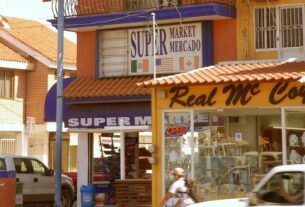Mexican Kitchen
The previous column on immigrant cooking in Mexico dealt with the Mennonites of Chihuahua, a group that brought Northern and Eastern European culinary traditions to their new country. A far different cuisine came with the Italians, who largely migrated during the Porfiriato, in the last part of the 19th century.
The great wave of migration from Europe during the late 19th and early 20th centuries was directed not only at the United States and Canada, but also several Latin American countries, including Mexico. The active recruiting of immigrants on the part of President Porfirio Díaz involved sending emissaries to European countries to extend invitations to settle in Mexico, with the aim of introducing new methods in agriculture and industry.
The Italians who followed Díaz’s call settled both in Mexico City and in “the provinces,” as the rest of Mexico was then called. Groups of people who came from agricultural regions in Italy relocated to similar areas in Mexico, bringing with them the traditions of home style country cooking, of food raised and prepared on their farms and ranches. One of these groups was from the province of Treviso, in the northern Italian region of Veneto, which, like Mexico, relied on corn as the staple food.
Díaz’s representatives arrived in Treviso at a time when the Piave river, which had been running dry for several years, overflowed its banks during a spring thaw, leaving much of the population homeless and the corn and other crops in a state of ruin. The snowmelt, on its way from the Alps to the Adriatic, washed away people’s hopes for any improvement in what were already difficult economic conditions. The time was ripe for the Mexican envoys to appeal to their desperation, and in 1882, a group of five hundred people from the villages of Segusino, Belluno and Feltre set out for their new home in Mexico.
They were given land to settle in the state of Puebla, on what had once been the Hacienda de Chipiloc. Perhaps because it sounded more Italian, the settlers dropped the final “c” and called their town Chipilo. Here they began farming and ranching and, with the expertise brought from their native Veneto, established a thriving dairy industry. The cheese and butter from this area are famous all over Mexico, and “Chipilo” is one of the country’s best-selling brands of butter and cream.
Italians had exerted an influence on Mexican eating habits long before the settlers from the Veneto region arrived, to the extent that by 1850, wheat pasta had become an alternative to the rice course. Mexican food historian Jeffrey Pilcher writes that Italians had a much greater influence than the French on Hispanic cuisine and that even in the colonial days Italian dishes had appeared in New Spain because of ties between the Castilian court and Giulio Alberoni, an Italian chef who later became de facto prime minister of Spain. This influence continued well into the 20th century, and today it is more the rule than the exception to see a separate pasta category on many menus throughout Mexico. But in no other part of the country did the Italians remain as close to their cultural and culinary roots as they did, and still do, in Chipilo, Puebla.
Here the language called Venet, with its Italian lilt and Latin and German roots, continues to be spoken, along with Spanish, even generations after the first immigrants arrived. People tend to marry within the town, and the same names have been passed on for over 120 years, as have the family recipes.
The diet of the northern Italian region, based on corn, rice, beans and vegetables, was very similar to that of Mexico, although there was a difference in the ways these ingredients were prepared. Corn was made into the porridge-like polenta rather than into masa for tortillas and other corn dough-based foods. Rice was prepared as risotto, with a creamier consistency than traditional Mexican style rice. Beans were combined with other foods, such as vegetables to make minestras, or soups, and pasta to make pasta e fagioli. And vegetables played an important role in all of it, especially the hearty winter varieties like cabbage and radicchio. Cippolini, or onions, were used to flavor a great many of these dishes.
With so many of the basic ingredients in common, it is not hard to see how a comfortable culinary fusion took place. The chipileños, as the people of Chipilo are called, learned to use the herbs and chiles common in their new country to flavor some of their traditional dishes. Thus were born lasagna with poblano chile strips and fettucine with mole sauce, among other foods dubbed “italo-mexicano.” Risottos and other rice specialties became fusion foods themselves, and today a typical Mexican white rice with the addition of red bell peppers, now widely available in the area, is a common dish.
With other foods, tradition held, especially the use of wine in the preparation of meat, poultry and game. The full-bodied red Cabernet de Treviso and the fruity white Prosecco of the Veneto region may have been replaced with more easily available substitutes, but wine remained an important part of cooking. The cordero al romero y vino tinto – lamb flavored with rosemary and red wine – and the conejo chipileño – rabbit with white wine and herbs – served in Chipilo today are essentially the same recipes brought by the grandmothers from Italy.
But the most famous of Chipilo’s culinary offerings are its dairy products. The cheese-making tradition of their native land was carried on in Mexico by the chipileños, whose native province of Treviso lies in the Asiago High Plateau and is the home of asiago, a mild, delicious cheese made with whole cow’s milk. It is the fresh asiago, called pressata, that is the forebear of the fresh pressed cheese sold in Chipilo today, often flavored with the Mexican herb epazote, or with chiles or sesame seeds.
A visitor to Chipilo, which lies twelve kilometers southeast of the city of Puebla, will not regret buying a round or two of this cheese, to be eaten along the way to the next destination or as a tasty hotel room snack. (Being fresh, rather than aged, it needs to be refrigerated if not consumed soon after purchase.) For lovers of Italian cold cuts – salumi – this is a good place to buy them as well. There are also several good restaurants with typical chipileño cooking along the Puebla-Atlixco highway where it runs past Chipilo and provides easy access into the town.
The country cooking of northern Italy combined with that of Central Mexico has produced a cuisine well worth sampling. The following recipes represent a cross-section of those using the herbs and vegetables prevalent in “italo-mexicano” cooking.
- Lasaña con Rajas de Chile Poblano: Lasagna with Poblano Chiles in Cream
- Conejo con Hierbas de Olor: Rabbit with Wine and Herbs
- Polenta con Requesón y Acelgas: Polenta with Fresh Cheese and Chard


